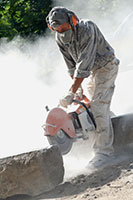 Despite what you may have heard, you don’t always need water when cutting with a diamond blade! Dry-cutting even has advantages over wet-cutting: you don’t need to clean up slurry after you’re done, you can cut in places without reliable water sources, and you’ll tend to get cleaner, crisper cuts.
Despite what you may have heard, you don’t always need water when cutting with a diamond blade! Dry-cutting even has advantages over wet-cutting: you don’t need to clean up slurry after you’re done, you can cut in places without reliable water sources, and you’ll tend to get cleaner, crisper cuts.
That being said, you can’t just slap any old blade on your saw and go to town without knowing what you’re doing.
First of all, you need to use a blade that’s designed for dry-cutting (may we suggest our Ductile Iron Safety Blade?). That’s because the water used in wet-cutting cools the blade. Cut without this cooling water, and you’ll quickly destroy a wet-cutting blade. Even worse, the heat will weaken the welds holding the cutting segments onto your blade, and if those segments break off during cutting, they may injure or kill you.
Second, you need to cut differently when dry-cutting. That’s because dry-cutting blades are cooled by air while cutting, and that air can’t get to the blade if you bury it deep in a cut. To get around this, you should step-cut – that is, cut an inch or so deep at a time – and periodically take the blade out of the cut to let it free-run and cool down.
Third, you need to wear a respirator when dry-cutting, especially if you cut concrete, brick, block, and stone. That’s because the water used in wet-cutting is one of the best ways to reduce dust while cutting. Without this water, you’ll inhale more silica dust, which can lead to lung diseases like silicosis, pneumoconiosis, and lung cancer.
In short, we’re not saying that you shouldn’t dry-cut. If you do, though, make sure that you have the right blade, the right cutting technique, and the right safety equipment for the job.



